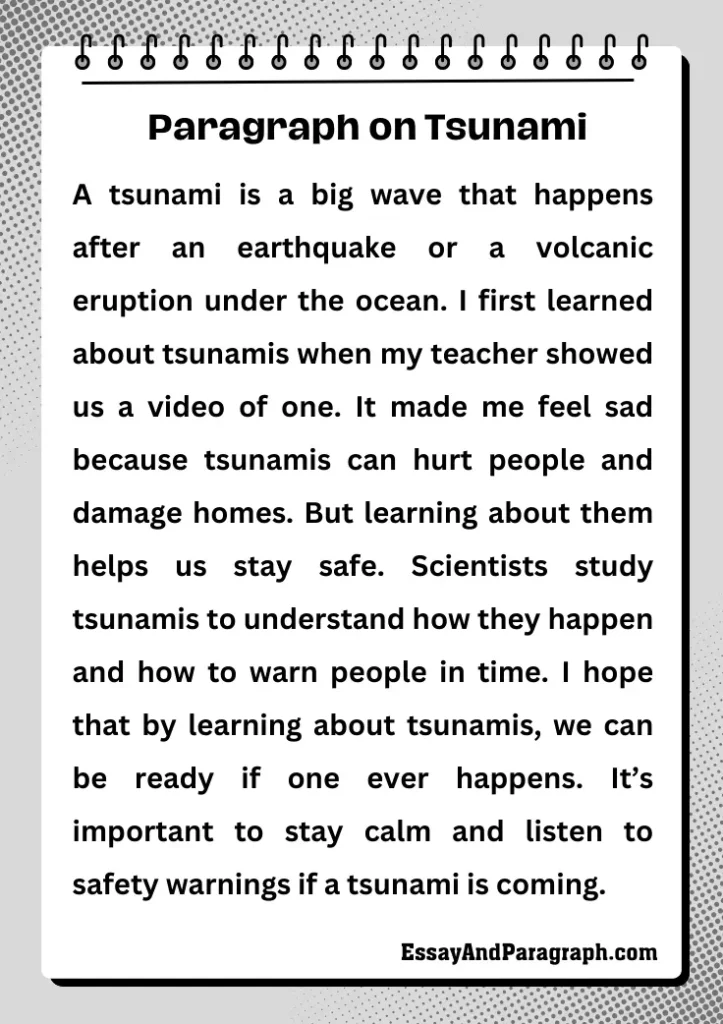In this article, we will learn how to write paragraphs on “Tsunami” in different lengths (100, 150, 200, 250, and 300 words). A tsunami is a huge wave that can be caused by an earthquake or a volcanic eruption under the sea. It is a powerful and dangerous event, but understanding how tsunamis happen can help us stay safe. In this article, we will explore what a tsunami is, how it forms, and why it’s important to know about them. Let’s dive into learning about these big waves and how we can stay prepared.
Paragraph on Tsunami – 100 Words
A tsunami is a big wave that happens after an earthquake or a volcanic eruption under the ocean. I first learned about tsunamis when my teacher showed us a video of one. It made me feel sad because tsunamis can hurt people and damage homes. But learning about them helps us stay safe. Scientists study tsunamis to understand how they happen and how to warn people in time. I hope that by learning about tsunamis, we can be ready if one ever happens. It’s important to stay calm and listen to safety warnings if a tsunami is coming.

Paragraph on Tsunami – 150 Words
Tsunamis are giant waves that can happen after an earthquake or a volcano eruption in the ocean. I first saw a tsunami in a movie, and it made me feel scared. Tsunamis are very powerful and can flood large areas of land. They happen when the ocean floor moves, pushing water up, which then creates a huge wave. When a tsunami happens, it’s important for people to get to higher ground to stay safe. In some places, there are warning systems that let people know a tsunami is coming. I think learning about tsunamis helps us understand how to stay safe if one happens. I expect that scientists will continue to study tsunamis to protect people in the future.
Paragraph on Tsunami – 200 Words
A tsunami is a very big wave that happens after an earthquake or a volcanic eruption. The waves can travel very fast across the ocean and cause a lot of damage when they hit the land. I remember hearing about a tsunami that happened in a country far away. It was so sad to see the destruction it caused. Tsunamis happen when the ocean floor moves, causing a huge wave to form. These waves can travel thousands of miles and get bigger as they reach the shore. The most dangerous part of a tsunami is not just the first wave but also the smaller waves that come after it. In many places, there are warning systems to help people know when a tsunami is coming. I think these warning systems are very important because they can help save lives. By studying tsunamis, scientists can figure out how to predict them better and help people stay safe. I hope that with more research, we will be able to protect people from the harm caused by tsunamis in the future.
Paragraph on Tsunami – 250 Words
A tsunami is a giant wave that forms when something, like an earthquake or a volcanic eruption, happens underwater. These waves are so strong that they can cause a lot of damage to the land and hurt people. I remember learning about a big tsunami that happened a long time ago. It was very sad because many people lost their homes. Tsunamis form when the ocean floor suddenly moves, causing the water to shift and make a huge wave. When the wave reaches the shore, it can get taller and taller, flooding the land. The biggest problem with tsunamis is that they can happen very quickly, so people may not have enough time to escape. However, in some places, there are warning systems that alert people when a tsunami is coming, so they can move to higher ground and be safe. Scientists work hard to understand how tsunamis happen, and they are learning better ways to predict them. It’s important to listen to warnings if a tsunami happens because it can help keep us safe. The more we understand about tsunamis, the better we can protect ourselves and others. I hope that in the future, scientists can continue to improve tsunami warnings and help save lives.
Paragraph on Tsunami – 300 Words
A tsunami is a large and dangerous wave that forms after a powerful earthquake or volcanic eruption under the ocean. These waves are much bigger than regular waves and can flood large areas of land, causing a lot of damage and sometimes even hurting people. I remember hearing about a tsunami in a faraway place, and it made me feel sad and worried. Tsunamis happen when the ocean floor moves suddenly, causing the water above it to rise and create a big wave. This wave then travels across the ocean at very fast speeds, sometimes reaching hundreds of miles per hour. As the wave reaches the shore, it grows taller and taller, flooding the land and sometimes destroying buildings and homes. The hardest part of a tsunami is that it can happen without warning, so people may not know in time to escape. However, in some countries, scientists have built special warning systems that can tell when a tsunami might happen. These warning systems can save lives because they help people get to higher ground and stay safe. Scientists are also working hard to understand more about tsunamis so they can predict them better in the future. I think it’s important to learn about tsunamis because when we know more, we can be safer. If a tsunami happens, it’s important to listen to the warning signals and stay calm. I believe that with more research and better warning systems, we can protect more people and keep them safe from the dangers of tsunamis in the future.
FAQs on Tsunami
What is a tsunami?
A tsunami is a giant wave that happens after an earthquake or a volcanic eruption under the ocean. These waves are much bigger than regular waves and can flood land and cause a lot of damage.
How do tsunamis form?
Tsunamis form when the ocean floor suddenly moves, like during an earthquake or volcanic eruption. This movement causes the water above to rise, creating a large wave that travels across the ocean.
Why are tsunamis dangerous?
Tsunamis are dangerous because they can cause a lot of damage to land and hurt people. The waves can get very tall and flood large areas, sometimes destroying buildings and homes.
How do people know a tsunami is coming?
In some places, there are warning systems that can detect when a tsunami is coming. These systems alert people so they can move to higher ground and stay safe. It’s important to listen to these warnings.
Can tsunamis happen anywhere?
Tsunamis usually happen in places near oceans and seas where there are earthquakes or volcanic eruptions. Some countries are more at risk, but scientists are working on ways to protect people everywhere.
Topic-Related Quotes
“Tsunamis remind us how small we are in the face of nature’s power.” – Unknown
“The ocean is a powerful and beautiful force, but also one to be respected.” – Unknown
“Sometimes, the biggest waves teach us the most.” – Unknown
“Tsunamis may be unpredictable, but we can always be prepared.” – Unknown
“In the face of a tsunami, we must stand strong, together.” – Unknown
“Safety in a tsunami is about listening to warnings and staying calm.” – Unknown
“A tsunami shows us that nature’s strength can change lives in an instant.” – Unknown
Summary on Tsunami
A tsunami is a huge wave that forms after a big earthquake or volcanic eruption under the ocean. These waves can travel across the ocean at very high speeds, getting taller as they reach the shore and causing a lot of damage. When a tsunami hits land, it can flood large areas, destroy buildings, and hurt people. However, there are warning systems in some places that help alert people when a tsunami is coming, so they can move to safer areas. Scientists are working hard to better understand and predict tsunamis to help keep people safe. Learning about tsunamis helps us know how to react in case one happens. It’s important to stay calm, listen to warnings, and be ready to move to higher ground when needed. With better understanding and technology, we can help protect more people in the future.




